Navigation
Install the app
How to install the app on iOS
Follow along with the video below to see how to install our site as a web app on your home screen.
Note: This feature may not be available in some browsers.
More options
You are using an out of date browser. It may not display this or other websites correctly.
You should upgrade or use an alternative browser.
You should upgrade or use an alternative browser.
The Roosevelt elk hunt of my dreams...
- Thread starter Bluffgruff
- Start date
Bluffgruff
Well-known member
Winds up to 50mph whip down the lake, though the gap left by the missing spruce branches and into our tent. Admittedly, we should have brough a different style of tent with lots of poles that weighs enough to keep itself rooted to the ground. The wind would smash one side of the tipi down, some flow would get under the canopy and then lift the opposite side over and over. Pulling stakes and tossing them 5-10 feet down wind. We re-stake 4 times overnight, rocks are in short supply inside the bear fence, but we get a few stakes rocked to keep the most vulnerable ones in place. We ultimately lose a stake when a wind gust catches the door, unzipping it, and catapulting the stake out into the night. As daylight neared, the wind eased and the rain started. A tent day seems inevitable. Seriously. This place is trying to demoralize us, and it's working.
Somehow, the bear fence remains steadfast through the gale.

We stick to tent and hot beverages for the morning.
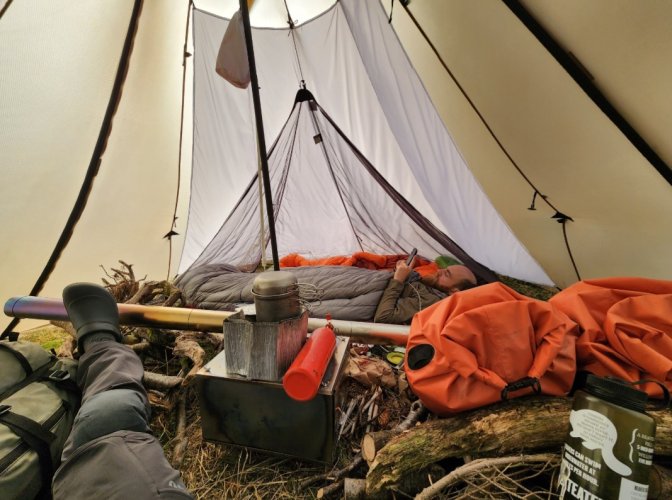
Toward afternoon, we motivate ourselves for a brief walk along the creek away from camp to look for signs of critters.
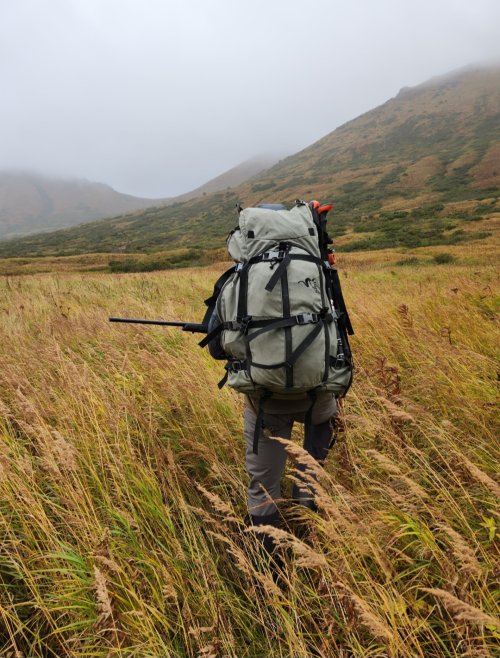
I find some salmonberries to test, though the flavor is terribly disappointing.

We keep finding plenty of evidence of the one we refer to as "Lassie" along the creek

We get to a spot to take in a claggy view of a nice alpine bowl out of view from camp, and out of the wind, but no deer or elk are present. We locate an impressive bear bed under a clump of spruce, and immediately begin to search for its tenant. It doesn't take long, a massive brown shape is moving in and out of salmonberry patches, scarfing huge mouthfuls at a time 450 meters away (Kiwi, switch your RF to 'Merican numbers please). I don't get a clear picture, but I promise he's in the middle by the devil's club.

We decide today is not the day to have a close encounter, so we move back towards camp, attempt to cross the creek to gain a better vantage, but reject the notion of wet boots and return to camp after a quick search for a dry crossing.
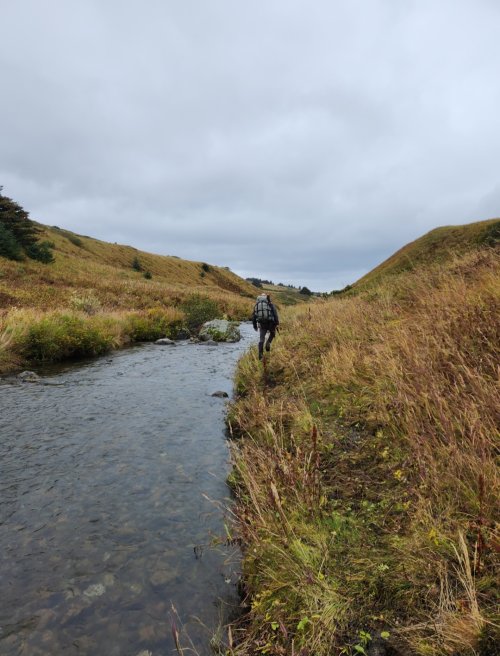

Somehow, the bear fence remains steadfast through the gale.

We stick to tent and hot beverages for the morning.

Toward afternoon, we motivate ourselves for a brief walk along the creek away from camp to look for signs of critters.

I find some salmonberries to test, though the flavor is terribly disappointing.

We keep finding plenty of evidence of the one we refer to as "Lassie" along the creek

We get to a spot to take in a claggy view of a nice alpine bowl out of view from camp, and out of the wind, but no deer or elk are present. We locate an impressive bear bed under a clump of spruce, and immediately begin to search for its tenant. It doesn't take long, a massive brown shape is moving in and out of salmonberry patches, scarfing huge mouthfuls at a time 450 meters away (Kiwi, switch your RF to 'Merican numbers please). I don't get a clear picture, but I promise he's in the middle by the devil's club.

We decide today is not the day to have a close encounter, so we move back towards camp, attempt to cross the creek to gain a better vantage, but reject the notion of wet boots and return to camp after a quick search for a dry crossing.


Bluffgruff
Well-known member
I should mention the Kiwi carried the 375 bear thumper tirelessly the entire time, either in hand or in a quick release sling, even to the food tree.
Bluffgruff
Well-known member
As evening approaches, we eat in the drizzle by the food tree, but get to dry out a bit with a stove fire. The wind is calm. Almost too calm. Without wind, you can hear all the noises of the night, some of which might just be bears.


But none of them are bears.
It rains heavily overnight, and that continues through late morning when we decide to don our raingear and attack the brushy hillscape (hellscape?)...

The going is slow to say the least, with head high salmonberries and a mix of grasses, forbs, and hidden benches full of alders. Tunneling through, we eventually find the alpine.


Until noon, there's a cloak of fog up to 1500 feet, short of our destination saddle, but the veil rapidly lifts and we're met with stunning views of the valley, bay, straight, and Katmai in the distance. It takes us 3.5 hours to climb 1500 feet.

Reaching a saddle as a bit of a "why not" moment, the Kiwi spots the creamy white blotch of a mountain goat below us in the mixed alders... nevermind, it's an elk, a bull even. We hurry down far enough to blunt the wind screaming through the saddle and get the spotting scope up. I put my bino adapter on the ground, the first of many pieces of temporarily lost equipment. The bull isn't very big, and he's missing most of a beam, but we're excited to see an elk.

Nearby, a "Lassie" is loosely trailing the broken bull, mostly eating berries. Both are within a few hundred yards of one of the most famous (infamous?) meat trees on the island.
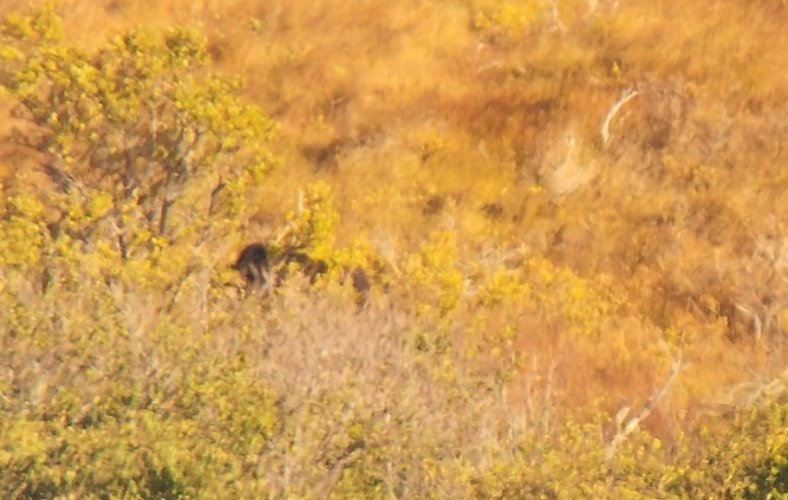
It turns out the "seeing elk" part isn't that hard, and we are turning up bulls and small herds with the naked eye, and inspecting each bull at 70x. Most are broken or immature. We move on to the next saddle overlooking the valley I had planned to hunt from my first time applying for this tag. We put binos on tripods.... or at least the Kiwi does; my adapter is still in the last saddle.

We find some doe and fawn blacktails along the ridges near the ocean, but no elk, despite the effort to glass meticulously, which turned out to be a waste of time. We try the next subvalley, and elk are absent there as well.

It's about 4pm, and we decide getting back in the daylight is key. We backtrack to get my bino adapter, then mull our decent. One last look at a medium bull through the spotter, and it's time to go.

Routes are important, and we talk about this one for a while. We don't want to be stuck in an alder prison when the light fades.

We choose wisely, and are in camp 1.5 hours after starting our decent.
The sunset is glorious, emphasizing the rugged beauty of the island.

The lake is calm as I filter water from the sandy shore.

Joining me on the beach are dozens of snipe. I'm not even messing with you. Flocks and flocks whistling by and landing within just a few yards. Here's one standing still long enough for a picture.

We get a fire started in the stove and dry our raingear. Rain and wind join us again overnight, but from our more sheltered western flank. We can't hear the bear-like noises, and the tent isn't in danger, so we sleep pretty well.


But none of them are bears.
It rains heavily overnight, and that continues through late morning when we decide to don our raingear and attack the brushy hillscape (hellscape?)...

The going is slow to say the least, with head high salmonberries and a mix of grasses, forbs, and hidden benches full of alders. Tunneling through, we eventually find the alpine.


Until noon, there's a cloak of fog up to 1500 feet, short of our destination saddle, but the veil rapidly lifts and we're met with stunning views of the valley, bay, straight, and Katmai in the distance. It takes us 3.5 hours to climb 1500 feet.

Reaching a saddle as a bit of a "why not" moment, the Kiwi spots the creamy white blotch of a mountain goat below us in the mixed alders... nevermind, it's an elk, a bull even. We hurry down far enough to blunt the wind screaming through the saddle and get the spotting scope up. I put my bino adapter on the ground, the first of many pieces of temporarily lost equipment. The bull isn't very big, and he's missing most of a beam, but we're excited to see an elk.

Nearby, a "Lassie" is loosely trailing the broken bull, mostly eating berries. Both are within a few hundred yards of one of the most famous (infamous?) meat trees on the island.

It turns out the "seeing elk" part isn't that hard, and we are turning up bulls and small herds with the naked eye, and inspecting each bull at 70x. Most are broken or immature. We move on to the next saddle overlooking the valley I had planned to hunt from my first time applying for this tag. We put binos on tripods.... or at least the Kiwi does; my adapter is still in the last saddle.

We find some doe and fawn blacktails along the ridges near the ocean, but no elk, despite the effort to glass meticulously, which turned out to be a waste of time. We try the next subvalley, and elk are absent there as well.

It's about 4pm, and we decide getting back in the daylight is key. We backtrack to get my bino adapter, then mull our decent. One last look at a medium bull through the spotter, and it's time to go.

Routes are important, and we talk about this one for a while. We don't want to be stuck in an alder prison when the light fades.

We choose wisely, and are in camp 1.5 hours after starting our decent.
The sunset is glorious, emphasizing the rugged beauty of the island.

The lake is calm as I filter water from the sandy shore.

Joining me on the beach are dozens of snipe. I'm not even messing with you. Flocks and flocks whistling by and landing within just a few yards. Here's one standing still long enough for a picture.

We get a fire started in the stove and dry our raingear. Rain and wind join us again overnight, but from our more sheltered western flank. We can't hear the bear-like noises, and the tent isn't in danger, so we sleep pretty well.
Last edited:
Potsie
Well-known member
I have the same issue with bino adapters. I’m on my third, but drilled a hole in it and tied it via p-cord to a carabiner on my bino harness.
I’m not saying it’s fool proof, because I’ll prove it wrong, but it’s helped.
I’m not saying it’s fool proof, because I’ll prove it wrong, but it’s helped.
Bluffgruff
Well-known member
Bluffgruff
Well-known member
We sleep waaay too well. Finally dragging ourselves to the frosty grass by the food tree just before 10am. The weather is spectacular.

We should already be stalking a bull, but instead, we're just smashing biscuits and gravy, coffee, and watching this mountain where the deer have suddenly materialized all across the slope from the alder line, likely drying out from the previous storm.

No big bucks appear, but there some adult 2x2s. We try a new route to a different saddle, and it turns out to be the best for our money. Just one 5 yard spot of head high salmonberries and a quick gulch crossing and it's smooth sailing to the alpine and a well used game trail. This is our route up for the rest of the week.


At the new saddle, we set up out of the worst of the wind behind a spruce to pick over the elk. Roughly 40 elk, 14 bulls total on the far side of the valley.
One close to the bottom has a big frame and lots of points, but he's in a bad spot and has several broken tines.

Another group higher up has 2 nice bulls, in a much better spot at the upper edge of the alders:

a 5x5 with a broken right 3rd:
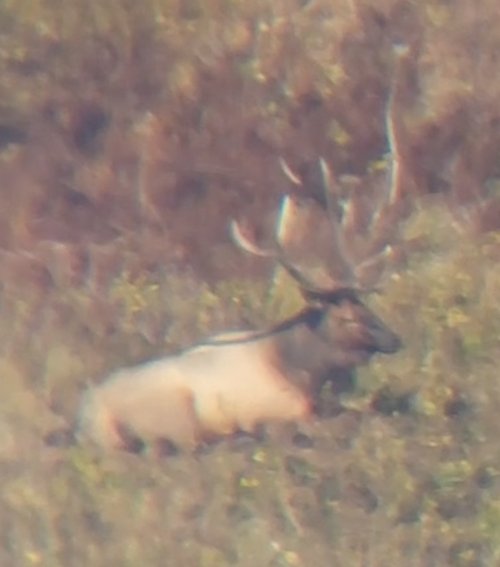
And this other bull that looks to be a 6x5 with all his points:
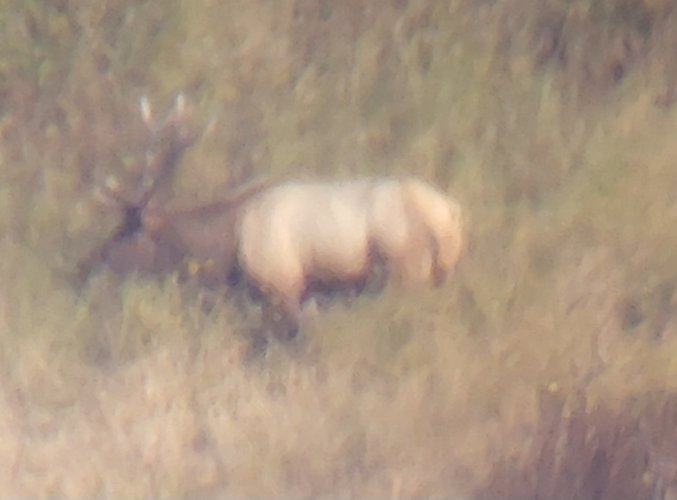
I desperately want to go after the last bull, but the Kiwi is hesitant. It's later in the day, heading back in the dark is almost guaranteed, and there are multiple Lassies below us. I begrudgingly agree to wait for the next day after a pouty attempt at convincing him that this is a once in a lifetime opportunity, that I'm never coming back, and that we need to take the bull in hand.
We take a scenic lunch break as we consider getting closer to the deer slope from the morning.

The views are just jaw dropping in every direction today. The low angle sun of Alaska brings a golden glow no matter the hour.

The most promising deer turns out to be a 3x3 at best, so we depart. We descend our route from the previous day and have dinner and a stove fire before dark.

I plan a route for the morning, give a pep talk about getting up and out early (mostly to myself) and then we get to bed. It's windy again, but from the sheltered direction, so no bear sounds and no tent concerns overnight.

We should already be stalking a bull, but instead, we're just smashing biscuits and gravy, coffee, and watching this mountain where the deer have suddenly materialized all across the slope from the alder line, likely drying out from the previous storm.

No big bucks appear, but there some adult 2x2s. We try a new route to a different saddle, and it turns out to be the best for our money. Just one 5 yard spot of head high salmonberries and a quick gulch crossing and it's smooth sailing to the alpine and a well used game trail. This is our route up for the rest of the week.


At the new saddle, we set up out of the worst of the wind behind a spruce to pick over the elk. Roughly 40 elk, 14 bulls total on the far side of the valley.
One close to the bottom has a big frame and lots of points, but he's in a bad spot and has several broken tines.

Another group higher up has 2 nice bulls, in a much better spot at the upper edge of the alders:

a 5x5 with a broken right 3rd:

And this other bull that looks to be a 6x5 with all his points:

I desperately want to go after the last bull, but the Kiwi is hesitant. It's later in the day, heading back in the dark is almost guaranteed, and there are multiple Lassies below us. I begrudgingly agree to wait for the next day after a pouty attempt at convincing him that this is a once in a lifetime opportunity, that I'm never coming back, and that we need to take the bull in hand.
We take a scenic lunch break as we consider getting closer to the deer slope from the morning.

The views are just jaw dropping in every direction today. The low angle sun of Alaska brings a golden glow no matter the hour.

The most promising deer turns out to be a 3x3 at best, so we depart. We descend our route from the previous day and have dinner and a stove fire before dark.

I plan a route for the morning, give a pep talk about getting up and out early (mostly to myself) and then we get to bed. It's windy again, but from the sheltered direction, so no bear sounds and no tent concerns overnight.
SwaggyD
Well-known member
- Joined
- Jan 26, 2022
- Messages
- 1,837
Awesome!!!
Bluffgruff
Well-known member
At 6am, my alarm goes off. Snooze. At 610am, it goes off again, and the Kiwi turns on the tent light. I pretend I was already awake, and we scurry through the frozen darkness to the food tree and return to eat breakfast in the cover of the tent and bear fence. Sunrise is after 8am, and around 745am, just as the dawn breaks, we're moving along the lake, turn up through the brush, juke through the salmonberries, then up to our trail and on to the saddle. We pause to inventory the elk. Not nearly as many are visible. We count 4 bulls, none of them the 3 larger ones from yesterday, scattered along the side valley, a spike up high, with a few more closer to the ocean. I give a pep talk to the Kiwi that we might just have to go to those, even though they're 1000 feet lower and another 1-2 miles farther.

We go up another 300 feet to the ridge crest then down again. Somewhere near the next saddle, a feeding bull becomes obvious near the ridge line in the next valley just east of where the spike had been. I dismiss the bull, thinking it's the spike having moved in the last 30 minutes, but the Kiwi thinks it's a different animal. We have to go that general direction to stalk into the side bowl we believe the broken 5x5 and 6x5 to have traveled overnight, so we keep tabs on him as we move up the ridge then towards the next saddle. Thinking he's an obstacle that may ruin a stalk more than a target, when he comes into view the next time at just under a mile, the Kiwi and I realize he has branched and substantial antlers, definitely not the spike I suspected. Now we're interested. He's by himself and well above the brush, close to the ridgeline, in a great spot to stalk, and where we think will be safer from bears.
We pass through another saddle and climb the next ridge, staying off the ridgeline. As the ridge circles towards the bull we get to 1100 yards, then 950, then 750, then 550.

We find a broken piece of elk antler beam, but leave it for the rodents. At 450 yards, hidden, I stab my trekking poles in the ground and get my rifle off my pack. A peek over the ridge confirms this is the 6x5 from the day before. Up until 400 yards, we're completely covered by the ridge, but we make another 50 yards with a scurry over the ridge top towards a krumholtz spruce when the bull turns away to feed. I get myself ready to shoot, 350 yards, quite a bit of wind. Scope dialed, parallax adjusted, and down on the rifle, there's just a little too much grass, so I slop my pack a few yards farther forward and try again. The Kiwi says to hold 8" of wind, and check my level. It feels like I'm well off vertical, but thats what the level is for, as I adjust my body awkwardly at an uphill angle. It finally feels right, and one more reminder to hold the wind.

At the shot, the bull drops and starts to slowly roll down hill. He hangs up about 20 yards down, but is still moving his head. I am having flashbacks to my Nevada bull, so I rechamber and cover him. He isn't getting up, but his head continues to thrash. I grab my pack and move to the bull while the Kiwi grabs my trekking poles behind us. When I arrive at the bull, he's still moving, so I put another shot in the back of his neck, just below the skull. It's 1140am. The shot was almost anticlimactic, but here he is, exactly what I wanted in a bull. I tie off his antlers to a tiny, beleaguered blueberry and turn to admire the massive animal. The fur is much lighter in coloration than other elk I've killed. The neck is massive, 41" under the ear, tape pulled tight.




We get a few pictures and through some serious effort, get his legs turned uphill and tied off to the same sad blueberry to attempt a cleaner butchering job. I want the full hide for a king size bed spread. The Kiwi says I can carry it, then.
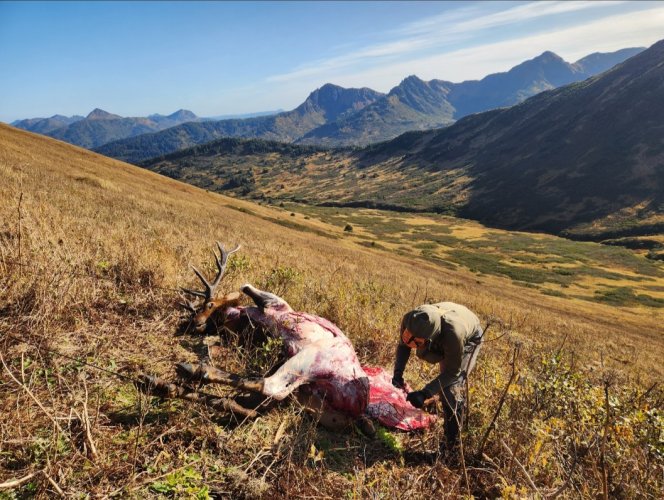
We start skinning, going all the way too the backbone. Carving the hind leg off, it becomes apparent neither of us can cleanly lift it alone on this slope, so we bag it up and double carry to a waiting tarp. It weighs 96lbs with bone. As we get the shoulder, brisket, neck, and rib meat, it's obvious this is much bigger than a rocky bull. We end up with over 380lbs of boned out meat. The hide weighs 67lbs. The head, after skinning, weighs 29lbs. I cut the two lower incisors out for aging later.
During the butchering process, we find the bullet had entered just below the backstrap slightly behind the shoulder, grazed the spine, and got both lungs, coming to rest mid-shoulderblade on the other side. The bullet is missing one petal that careened through the lungs and exited fully through the lower off-side near the elbow.
We carry all the bagged meat, hide, and head about 75 yards to a lone spruce. We roll the carcass down towards the creek and the alders, trying to keep the guts away from the meat. We have good visibility here, but expect visitors. Nothing left except a greasy smashed spot in the grass when we're done.
We fence the meat and cover it loosely with a tarp.



It takes about two hours to return to camp, but the weather is nice, and the evening sun sets a golden glow across the hillside.


We go up another 300 feet to the ridge crest then down again. Somewhere near the next saddle, a feeding bull becomes obvious near the ridge line in the next valley just east of where the spike had been. I dismiss the bull, thinking it's the spike having moved in the last 30 minutes, but the Kiwi thinks it's a different animal. We have to go that general direction to stalk into the side bowl we believe the broken 5x5 and 6x5 to have traveled overnight, so we keep tabs on him as we move up the ridge then towards the next saddle. Thinking he's an obstacle that may ruin a stalk more than a target, when he comes into view the next time at just under a mile, the Kiwi and I realize he has branched and substantial antlers, definitely not the spike I suspected. Now we're interested. He's by himself and well above the brush, close to the ridgeline, in a great spot to stalk, and where we think will be safer from bears.
We pass through another saddle and climb the next ridge, staying off the ridgeline. As the ridge circles towards the bull we get to 1100 yards, then 950, then 750, then 550.

We find a broken piece of elk antler beam, but leave it for the rodents. At 450 yards, hidden, I stab my trekking poles in the ground and get my rifle off my pack. A peek over the ridge confirms this is the 6x5 from the day before. Up until 400 yards, we're completely covered by the ridge, but we make another 50 yards with a scurry over the ridge top towards a krumholtz spruce when the bull turns away to feed. I get myself ready to shoot, 350 yards, quite a bit of wind. Scope dialed, parallax adjusted, and down on the rifle, there's just a little too much grass, so I slop my pack a few yards farther forward and try again. The Kiwi says to hold 8" of wind, and check my level. It feels like I'm well off vertical, but thats what the level is for, as I adjust my body awkwardly at an uphill angle. It finally feels right, and one more reminder to hold the wind.

At the shot, the bull drops and starts to slowly roll down hill. He hangs up about 20 yards down, but is still moving his head. I am having flashbacks to my Nevada bull, so I rechamber and cover him. He isn't getting up, but his head continues to thrash. I grab my pack and move to the bull while the Kiwi grabs my trekking poles behind us. When I arrive at the bull, he's still moving, so I put another shot in the back of his neck, just below the skull. It's 1140am. The shot was almost anticlimactic, but here he is, exactly what I wanted in a bull. I tie off his antlers to a tiny, beleaguered blueberry and turn to admire the massive animal. The fur is much lighter in coloration than other elk I've killed. The neck is massive, 41" under the ear, tape pulled tight.




We get a few pictures and through some serious effort, get his legs turned uphill and tied off to the same sad blueberry to attempt a cleaner butchering job. I want the full hide for a king size bed spread. The Kiwi says I can carry it, then.

We start skinning, going all the way too the backbone. Carving the hind leg off, it becomes apparent neither of us can cleanly lift it alone on this slope, so we bag it up and double carry to a waiting tarp. It weighs 96lbs with bone. As we get the shoulder, brisket, neck, and rib meat, it's obvious this is much bigger than a rocky bull. We end up with over 380lbs of boned out meat. The hide weighs 67lbs. The head, after skinning, weighs 29lbs. I cut the two lower incisors out for aging later.
During the butchering process, we find the bullet had entered just below the backstrap slightly behind the shoulder, grazed the spine, and got both lungs, coming to rest mid-shoulderblade on the other side. The bullet is missing one petal that careened through the lungs and exited fully through the lower off-side near the elbow.
We carry all the bagged meat, hide, and head about 75 yards to a lone spruce. We roll the carcass down towards the creek and the alders, trying to keep the guts away from the meat. We have good visibility here, but expect visitors. Nothing left except a greasy smashed spot in the grass when we're done.
We fence the meat and cover it loosely with a tarp.



It takes about two hours to return to camp, but the weather is nice, and the evening sun sets a golden glow across the hillside.

BAKPAKR
Well-known member
Congrats on a great bull and an amazing adventure!
Bluffgruff
Well-known member
The next morning, we're both sore from 3 days of the 1300ft+ daily climb and rolling around the massive elk, so I'm not up til 730am. Daylight is easing into the valley when I get out of the tent to retrieve the food bags.
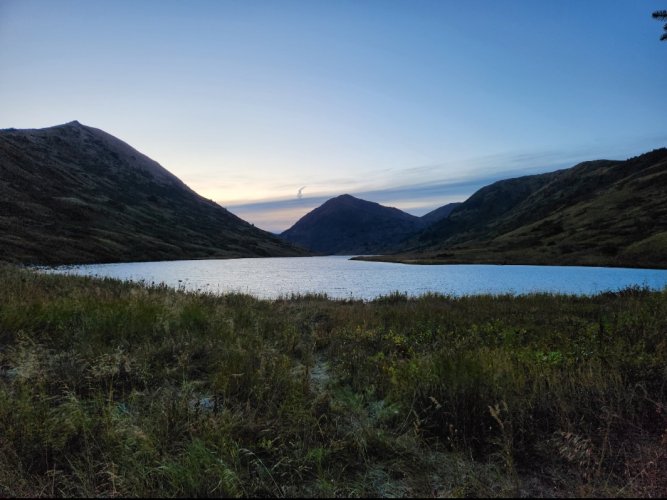
We pick out a tree for the next meat cache in the middle saddle, as close to a float plane pickup spot as possible, and continue on the ridgeline.
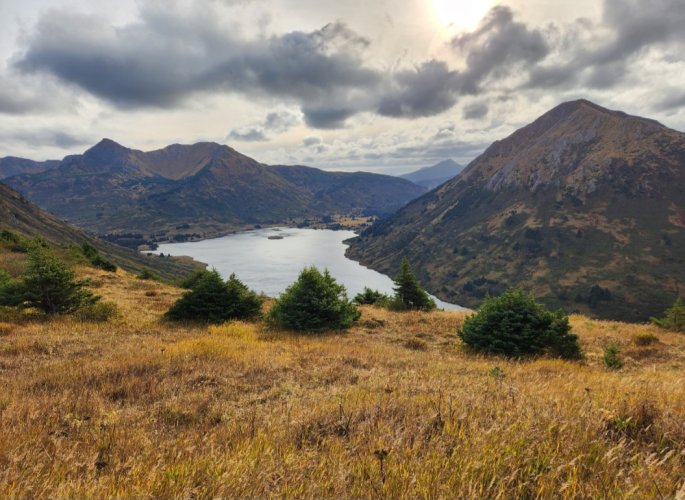
We make our way to the cache tree, yelling, "Hey Lassie!" because we don't say bear unless there's a bear. With good visibility, we can ascertain the fence is up and no brown blobs are around from a fair distance.

Arriving at the tree, there are no fresh tracks of anything in the bare dirt of the adjacent mineral lick. The wind changes from calm to a strong east northeast. I mention to the Kiwi that on any of our return trips, we might come upon a Lassie. We pack the boned hams and cinch them tight. I state that I'm going to weigh my pack, and ask the Kiwi if he wants to weigh his. He says he would rather not know. I kneel to grab my scale and the Kiwi exclaims, "Oh shit there's a bear!"
The next 3-4 seconds pass agonizingly slowly. The Kiwi is crouched, but stands with his pistol drawn, flicking the battle holster off as he rises, I rip my pistol from it's holster, chambering as I stand, to track the enormous brown mass running down at the Kiwi.
The bear skitters to a halt when it figures it is outnumbered and outflanked, 15 yards from the Kiwi. It looks back and forth from one of us to the other as I take 2 steps up the hill to get sure footing and full view. The bear starts trotting at 90 degrees from us as we continue our loudest possible challenges. As he starts down the hill. He hesitates a few times. I move to the open mineral lick, continue yelling, but when the bear stops at 100 yards and won't exit further, I fire three warning shots off to his right. He dives into an alder patch. I walk to where the bear stopped. And take a picture down to where he's hidden himself in the alders. Then the spot he came to a halt, then back towards the Kiwi, still watching the alder patch.


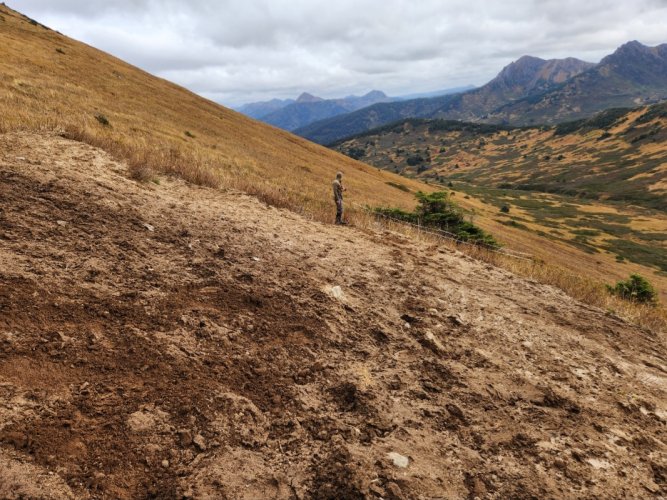

Debriefing quickly, the wind had changed, and the bear, that we estimated was a young adult male of 700-800lb, was likely on the other side of the ridge. The top of the mineral lick provided a bit of a blind spot. The Kiwi saw the bear as it peeked over the rim, 30 yards away, just as it started to run down on us. I first saw the bear at about 25 yards, and in the amount of time it took to stand, it had made it almost 10 yards.
We both feel lucky we were facing that direction at that key moment.
Back to packing meat. My pack weighs 95lbs, the Kiwi's more like 115lbs. We pack 3 loads each between 95 and 125lbs(including what was already in our packs) to a halfway spot on the next ridge...

...then shuttle to the tree we picked out on the ridge on the way up that morning.
We're both properly exhausted. The wind picks up to 40, 50mph on exposed ridges, with gusts to 60mph at least, often knocking us off balance, especially when I'm carrying the last load, a 115lb mistake topped by a sail.

We roll up the bear fence with that last load and move it to the next tree, just as the rain starts.


By the next saddle, the one with the game trail leading towards camp, the wind is consistently over 50mph. The rain stings. The storm is roiling. This is much worse than the storm that started the trip.


We pick out a tree for the next meat cache in the middle saddle, as close to a float plane pickup spot as possible, and continue on the ridgeline.

We make our way to the cache tree, yelling, "Hey Lassie!" because we don't say bear unless there's a bear. With good visibility, we can ascertain the fence is up and no brown blobs are around from a fair distance.

Arriving at the tree, there are no fresh tracks of anything in the bare dirt of the adjacent mineral lick. The wind changes from calm to a strong east northeast. I mention to the Kiwi that on any of our return trips, we might come upon a Lassie. We pack the boned hams and cinch them tight. I state that I'm going to weigh my pack, and ask the Kiwi if he wants to weigh his. He says he would rather not know. I kneel to grab my scale and the Kiwi exclaims, "Oh shit there's a bear!"
The next 3-4 seconds pass agonizingly slowly. The Kiwi is crouched, but stands with his pistol drawn, flicking the battle holster off as he rises, I rip my pistol from it's holster, chambering as I stand, to track the enormous brown mass running down at the Kiwi.
The bear skitters to a halt when it figures it is outnumbered and outflanked, 15 yards from the Kiwi. It looks back and forth from one of us to the other as I take 2 steps up the hill to get sure footing and full view. The bear starts trotting at 90 degrees from us as we continue our loudest possible challenges. As he starts down the hill. He hesitates a few times. I move to the open mineral lick, continue yelling, but when the bear stops at 100 yards and won't exit further, I fire three warning shots off to his right. He dives into an alder patch. I walk to where the bear stopped. And take a picture down to where he's hidden himself in the alders. Then the spot he came to a halt, then back towards the Kiwi, still watching the alder patch.




Debriefing quickly, the wind had changed, and the bear, that we estimated was a young adult male of 700-800lb, was likely on the other side of the ridge. The top of the mineral lick provided a bit of a blind spot. The Kiwi saw the bear as it peeked over the rim, 30 yards away, just as it started to run down on us. I first saw the bear at about 25 yards, and in the amount of time it took to stand, it had made it almost 10 yards.
We both feel lucky we were facing that direction at that key moment.
Back to packing meat. My pack weighs 95lbs, the Kiwi's more like 115lbs. We pack 3 loads each between 95 and 125lbs(including what was already in our packs) to a halfway spot on the next ridge...

...then shuttle to the tree we picked out on the ridge on the way up that morning.
We're both properly exhausted. The wind picks up to 40, 50mph on exposed ridges, with gusts to 60mph at least, often knocking us off balance, especially when I'm carrying the last load, a 115lb mistake topped by a sail.

We roll up the bear fence with that last load and move it to the next tree, just as the rain starts.


By the next saddle, the one with the game trail leading towards camp, the wind is consistently over 50mph. The rain stings. The storm is roiling. This is much worse than the storm that started the trip.

Irrelevant
Well-known member
jeezus.
NOPE
NOPE
SC Living Outdoors
Well-known member
Heck of an adventure. Congrats man.
jeezus.
NOPE
There’s currently a hostile trade embargo imposed on me hunting in grizz country by the president of my household.
This story to me proves as evidence both for and against lifting the embargo.
“See hun, they always run away!”
2rocky
Well-known member
- Joined
- Jul 23, 2010
- Messages
- 5,167
I like this procedure....Saving for future...We make our way to the cache tree, yelling, "Hey Lassie!" because we don't say bear unless there's a bear. With good visibility, we can ascertain the fence is up and no brown blobs are around from a fair distance.
D
Deleted member 52098
Guest
I have the same embargo, but with a catch: I am not allowed to apply for a unit in grizzly country, but if friends / hunting partners are going and need help, I can go. I guess the theory is that I'll be less focused on finding and animal and more focused on not being bear food haThere’s currently a hostile trade embargo imposed on me hunting in grizz country by the president of my household.
This story to me proves as evidence both for and against lifting the embargo.
“See hun, they always run away!”
Bluffgruff
Well-known member
We arrive to our tent, and it is collapsed. The carbon fiber pole split and fell, likely after a wind gust ripped the door zipper open. The tent fabric and the contents all seem intact.
We splint the pole with tape and firewood, and the Kiwi holds the pole and the tent fabric against the gale while I heat water for dehy. Halfway through eating, a 70mph gust surprises us and the pole simply snaps. We're wearing the tent like baggy rain gear trying to figure what's next. I have a small but sturdy backpacking tent, and we are thinking pitch it inside the other tent, place all the gear under a tarp, and roll the big tent up and stash it. I finish eating my dehy, trying to figure a way we can keep the big tent up. My idea is to cut a spruce limb the right length and make it the new pole. It works.
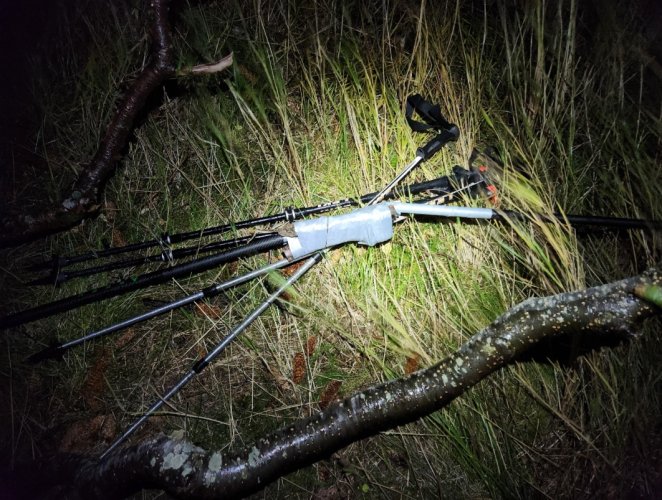

The spruce flexes some with the wind, but does the job. We still have the issue of tent stakes pulling, and the concern of a seam rip, so the Kiwi holds the tent fabric with his shoulders while I exit the bear fence to get bigger rocks. Eventually, all the stakes are well rocked, all the lines are tight, and the tent seems like it might survive. This is around 11pm. We decide someone should be awake to change the tent fabric harmonic and fix any issues the wind, still blowing 40-70mph, creates. I volunteer, since staying up all night has been my thing for years (also, this whole hunt is my doings). Around 4am, the gusts decrease, and my vigil is over. I pass out for about 6 hours.
When I wake up, we still have to get the meat to the lake. The pilot is coming a day early, arriving late morning the next day. We make our final trip up the game trail, making lots of noise and observing the cache for 5-10 minutes from 150 yards before moving in to start moving meat down hill.

Through a mix of carrying, dragging, and rolling, we have everything down a the bottom of the hill 3 hours later. The Kiwi brings the rack down the last shuttle segment to the flats.

We tree the meat just off the ground for drying, and fence it once more.

We talk to one of the groups of cow hunters who have been dropped earlier in the day, and then we decide to travel down the lake the 1.7 miles instead of going back up to the ridge line. Generally not that bad, there are some areas of alders, and narrow game trails above the rocky lake shore. In one particularly narrow spot, with the light fading, the bank lip gives way, and I fall 18" down to another lip, which also fails, sending me 6 feet down into the lake in about 18" of water. I'm mostly unhurt, but I gouge some skin off my right hand that bleeds all the way to camp, leaving a trail down my trekking pole that I keep rinsing to prevent a fresh blood trail all the way to our sleeping bags.

Towards the end, it's dark, and the trail above the lake is thick, so the Kiwi says, "**** it! and wades through the water the last 200 yards. The tent has a bit more of that wet boot flavor tonight.
It's windy and rainy overnight, but we sleep well. The next day, pickup is at 11, but at 845, just as we put water on to boil, our pilot asks if we want to be out sooner, since he's dropping another group off. We turn the water off and scramble to get everything stashed, stowed, and packed. Our pilot glides down a short time later, a group of Alaskans gets off for the cow hunt, and we get on. We do a quick flight to the far end of the lake and load up our meat. We are finally done.

Taking off this time is such a huge relief. We cruise back to the pond, and get meat to where it's going, and then our gear to the hotel to dry out.
That night, we toast to "surviving."

Referring back to my first post. This trip was miserable, we needed every ounce of toughness we could muster, and we didn't give up. The Kiwi made this hunt possible. He was level headed, strong, positive, and game for the bear encounter when it materialized.
Thanks Dan, I owe you big!
We splint the pole with tape and firewood, and the Kiwi holds the pole and the tent fabric against the gale while I heat water for dehy. Halfway through eating, a 70mph gust surprises us and the pole simply snaps. We're wearing the tent like baggy rain gear trying to figure what's next. I have a small but sturdy backpacking tent, and we are thinking pitch it inside the other tent, place all the gear under a tarp, and roll the big tent up and stash it. I finish eating my dehy, trying to figure a way we can keep the big tent up. My idea is to cut a spruce limb the right length and make it the new pole. It works.


The spruce flexes some with the wind, but does the job. We still have the issue of tent stakes pulling, and the concern of a seam rip, so the Kiwi holds the tent fabric with his shoulders while I exit the bear fence to get bigger rocks. Eventually, all the stakes are well rocked, all the lines are tight, and the tent seems like it might survive. This is around 11pm. We decide someone should be awake to change the tent fabric harmonic and fix any issues the wind, still blowing 40-70mph, creates. I volunteer, since staying up all night has been my thing for years (also, this whole hunt is my doings). Around 4am, the gusts decrease, and my vigil is over. I pass out for about 6 hours.
When I wake up, we still have to get the meat to the lake. The pilot is coming a day early, arriving late morning the next day. We make our final trip up the game trail, making lots of noise and observing the cache for 5-10 minutes from 150 yards before moving in to start moving meat down hill.

Through a mix of carrying, dragging, and rolling, we have everything down a the bottom of the hill 3 hours later. The Kiwi brings the rack down the last shuttle segment to the flats.

We tree the meat just off the ground for drying, and fence it once more.

We talk to one of the groups of cow hunters who have been dropped earlier in the day, and then we decide to travel down the lake the 1.7 miles instead of going back up to the ridge line. Generally not that bad, there are some areas of alders, and narrow game trails above the rocky lake shore. In one particularly narrow spot, with the light fading, the bank lip gives way, and I fall 18" down to another lip, which also fails, sending me 6 feet down into the lake in about 18" of water. I'm mostly unhurt, but I gouge some skin off my right hand that bleeds all the way to camp, leaving a trail down my trekking pole that I keep rinsing to prevent a fresh blood trail all the way to our sleeping bags.

Towards the end, it's dark, and the trail above the lake is thick, so the Kiwi says, "**** it! and wades through the water the last 200 yards. The tent has a bit more of that wet boot flavor tonight.
It's windy and rainy overnight, but we sleep well. The next day, pickup is at 11, but at 845, just as we put water on to boil, our pilot asks if we want to be out sooner, since he's dropping another group off. We turn the water off and scramble to get everything stashed, stowed, and packed. Our pilot glides down a short time later, a group of Alaskans gets off for the cow hunt, and we get on. We do a quick flight to the far end of the lake and load up our meat. We are finally done.

Taking off this time is such a huge relief. We cruise back to the pond, and get meat to where it's going, and then our gear to the hotel to dry out.
That night, we toast to "surviving."

Referring back to my first post. This trip was miserable, we needed every ounce of toughness we could muster, and we didn't give up. The Kiwi made this hunt possible. He was level headed, strong, positive, and game for the bear encounter when it materialized.
Thanks Dan, I owe you big!
Similar threads
Latest posts
-
-
Montana Legislator wishes to Join Utah land grab, Resolution.
- Latest: shoots-straight
-
-







